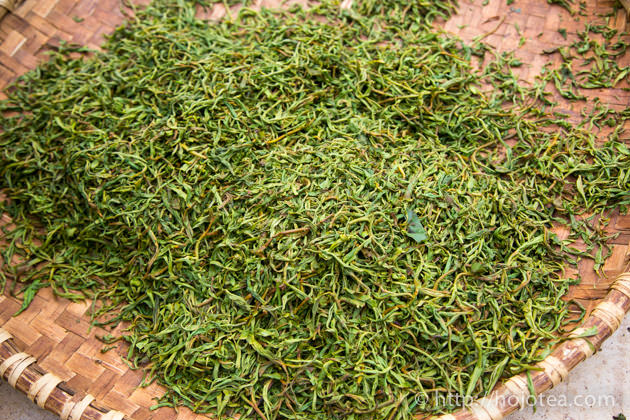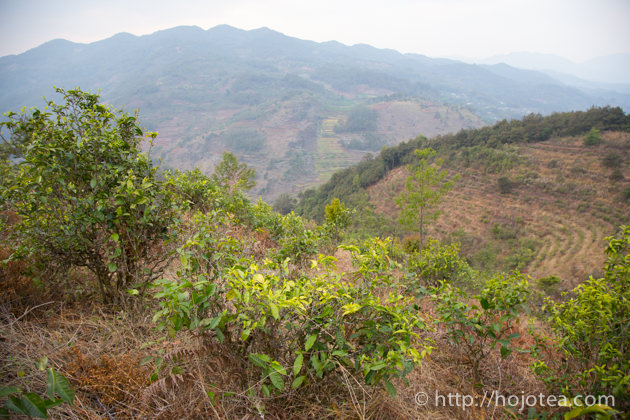- HOME >
- Origin of Tea
HOJO original tailor-made tea from Yunnan
- [2016.04.06] Posted By Akira Hojo
In HOJO’s tea lineup, we have many teas produced in Yunnan Province of China. We are always interested in Yunnan tea because if we work very hard to search we are still able to find some natural farming tea gardens in Yunnan. The quality of tea collected from those natural farming gardens is outstanding; in particular the aftertaste is very long-lasting. However, we also do have a dilemma with Yunnan tea. Many tea manufacturers in Yunnan are very rough in tea handling and processing management. In most cases, the fresh tealeaf is damaged and turned into dark color before it reaches the tea factory. Despite the fresh tea leaf is of good quality, it is often spoiled during the process of tea making. As we are well aware of these problems, we practice unique method to manage the quality of our teas.
Tailor-made tea
Since 2015 we stopped buying the ready-made tea directly from tea manufacturers. Instead, we request the reliable tea manufacturers to produce the tailor-made tea for us. Before 2015, we often visit the tea manufacturer and evaluate the teas they have already produced. We conduct series of tasting and we buy the particular bags of tea if we found the quality is meeting our requirements. Literally we were buying from the manufacturer. However, I felt we could get even better tea if we manage some aspects as follow.
- We select the tea garden and the section to collect fresh tea leaves
- We specify the plucking standard
- We specify the process parameter
Select the ideal tea garden
In Yunnan, tea gardens, especially those consist of old tea trees, are generally owned by the minority ethnics who lives in mountain. They pluck tea and sell the fresh leaves to the tea manufacture. Sometimes they also produce tea themselves and sell as raw pu-erh teas. But their skill in making tea is obviously very unrefined and too wild. They are lack of consistent control on the tea process parameter. They often burn the tea and tea usually has many other quality defects. The tea manufactures purchases tea from many farmers and usually classifies the leaves according to their own criteria. If we want to produce tea from the garden we like, we need to visit there before tea season starts and clearly specify the exact location for the farmers to collect tea. We usually specify the area, garden and what type of tea tree. I usually give them a few criteria to make sure that our teas are collected from the natural farming garden.
Plucking standard
There are a few different plucking standards for pu-erh tea, such as 1 bud 1 leaf, 1 bud 2 leaves, 1 bud 3 leaves and random plucking. The plucking standard affects the flavor and taste of tea. So we always like to determine the plucking standard for the each tea according to cup characteristic we want. For example, we request 1 bud 2 leaves for making Yan Ming Shan raw pu-erh tea in order to emphasize its creamy texture and mellow taste. On the contrary, we request 1 bud and 3-4 leaves for Wu Liang Shan and Ma An Shan raw pu-erh in order to get stronger taste, less bitter and fruity flavor.
Customized process
In making pu-erh tea, there are a huge variance among the manufacturer in regards of withering time and pan-frying method. The longer the withering is conducted, the lesser the moisture remains in tealeaf. Eventually it is very difficult to manage the pan-frying process because of tealeaf with less moisture content will easily burnt. However, if pu-erh tea is produced without sufficient withering process, it tends to give greenish flavor (箐味). Nowadays, there are more and more tea manufacturers conduct very light pan-frying, and the enzyme is still active for further fermentation during the sunshine drying process. With this light pan-frying method, they can get rid of the greenish flavor as floral flavor is developed during the sunshine drying process. Tea gives flavor reminiscent of light fermented oolong tea. However, the lightly pan-fried tea is not very ideal for aging. We always like to manage both withering and pan-frying so as to produce the tea that is nice to drink when it is fresh as well as ideal for aging. Besides pu-erh teas, we also tailor-made our black tea and white tea.
I have been kept visiting Yunnan Province since 2010. But we only started implementing the tailor-made tea production since 2015. For tailor-made tea, we need to responsible for the tea we requested. This method is relatively more risky if we do not know how to determine the tea leaves, agriculture, and manufacturing process. Nevertheless, most importantly we must have a good relationship and mutual understanding with the tea manufacturer to share the philosophy in tea as us did. In fact, we are not the only one who buys tea in tailor-made production style. Some China tea companies who are extremely particular about the quality do practice the tailor-made production too. Since we are improving many aspects year by year, I am pretty much looking forward to tasting the latest tea we commissioned.
Related Articles
How to get the latest update on HOJO?
1. Follow Twitter, 2. Click "Like" on Facebook, and 3. Subscribe in newsletter. You can have the latest tea news from HOJO.
 Subscribe the Newsletter to enjoy the privileges
Subscribe the Newsletter to enjoy the privileges- You may receive a free sample upon purchase, or you may have the priority to purchase special products. So please remember to subscribe our newsletter as well as the social network.
- Myanmar White Tea Bud 2013 from Guo Gan, Myanmar
- We have released a raw Pu-erh tea, 緬甸白芽茶 2013 (Myanmar White Tea Bud 2013), produced by ethnic minorities in t …
- Yong De Wild White Tea 2025 Loose Leaf Limited Release
- We have released Yong De Wild White Tea Loose 2025. For the 2025 harvest, only the loose-leaf type was …
NEW ARTICLES
 Myanmar White Tea Bud 2013 from Guo Gan, Myanmar
Myanmar White Tea Bud 2013 from Guo Gan, Myanmar- We have released a raw Pu-erh tea, 緬甸白芽茶 2013 (Myanmar White Tea Bud 2013), produced by ethnic minorities in t …
 Yong De Wild White Tea 2025 Loose Leaf Limited Release
Yong De Wild White Tea 2025 Loose Leaf Limited Release- We have released Yong De Wild White Tea Loose 2025. For the 2025 harvest, only the loose-leaf type was …
 Experience the True Freshness of Raw Pu-erh : Tang Jia 2025 Loose Leaf Release
Experience the True Freshness of Raw Pu-erh : Tang Jia 2025 Loose Leaf Release- We have released Tang Jia Raw Pu-erh Tea 唐家古樹生茶 2025 Loose Leaf. Among HOJO’s raw pu-erh teas, Tang Jia Raw Pu …
 Yunnan Chun Jian Green Tea from High Mountain Gardens
Yunnan Chun Jian Green Tea from High Mountain Gardens- Yunnan Chun Jian Green Tea is now available. This tea is made from naturally grown leaves harvested from high …
 Limited Loose Leaf Release of 2025 Da Xue Shan Wild Raw Pu-erh Tea
Limited Loose Leaf Release of 2025 Da Xue Shan Wild Raw Pu-erh Tea- We have released the 2025 loose-leaf version of Da Xue Shan Wild Raw Pu-erh Tea. This tea comes from wild tea …
 Discover a New Way to Enjoy Tea: Cooking Rice with Tea
Discover a New Way to Enjoy Tea: Cooking Rice with Tea- Cooking rice with tea is a simple idea, but it brings surprisingly satisfying results. The tea’s flavour seeps …
 2025 Da Xue Shan Wild White Tea Now Available from Yunnan
2025 Da Xue Shan Wild White Tea Now Available from Yunnan- The 2025 harvest of Da Xue Shan Wild White Tea is now available. Crafted from truly wild Camellia taliensis tr …
 Fresh 2025 Yunnan White Tea – Select Your Favourite Lot Before Blending
Fresh 2025 Yunnan White Tea – Select Your Favourite Lot Before Blending- Freshly crafted in Yunnan and just arrived in KL, our new 2025 white tea is now available at our Gardens Mall …
 2024 Dong Shan Raw Pu-erh Tea – Crafted with the Producer for Desired Quality
2024 Dong Shan Raw Pu-erh Tea – Crafted with the Producer for Desired Quality- We have released the 2024 cake of Dong Shan Raw Pu-erh Tea. Earlier, we offered the loose-leaf version from th …
 Development of Firewood Roasted Hojicha Using Naturally Grown Tea from Yunnan
Development of Firewood Roasted Hojicha Using Naturally Grown Tea from Yunnan- We are currently staying in Yunnan Province for tea production. As the season nears its end, tea trees with pa …
Category
- New Arrival at HOJO Online Shop
- Featured Articles
- Newsletter
- Types of Tea
- Origin of Tea
- Teapot and Tea Equipment
- Tea Column
- How to enjoy tea
- Tea Processing
- How to choose quality tea
- Tea constituents and functional effect
- Safety of Tea
- Foods
- Tea Business Operation
- Hobby and Outdoor Activity
- Ranking of Tea
- Video
- FAQ
- Media Release
Profile

- AKIRA HOJO
- I invite you to experience my tea selections.I was born in Nagano, Japan. In university, I studied agricultural chemistry, and I have the master degree in food science. I worked in Japanese food industry for 10 years. I involved in R&D, QC and QA. As a factory manager, I implemented ISO9000 series and managed the factory.
- The Art of Tea Magazine
- We posted the article on “The Art of Tea Magazine No.9, the magazine is published in Taiwan. We featured …
- New Straits Times
- The Malaysian National Newspaper, New Straits Times featured HOJO Tea on 17-Oct-2007.
Shop Info

Address:Lot No. T-215, 3rd Floor, The Gardens Mall, Mid Valley City, Lingkaran Syed Putra, 59200 Kuala Lumpur
Tel: +603-2287-4537
Business Hour: 10am to 10pm

















